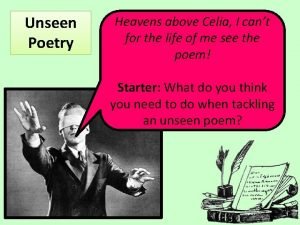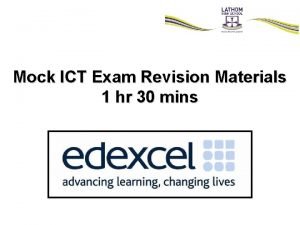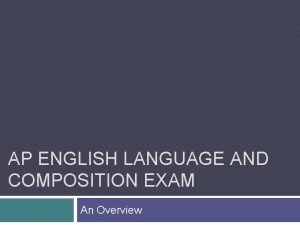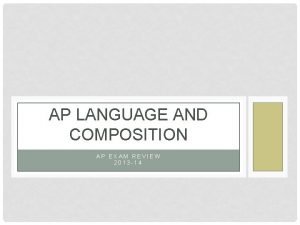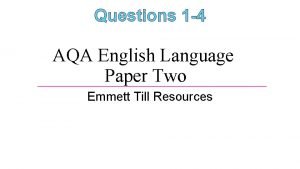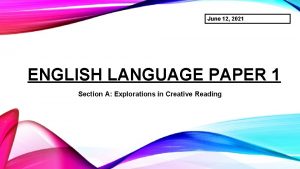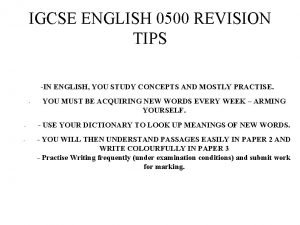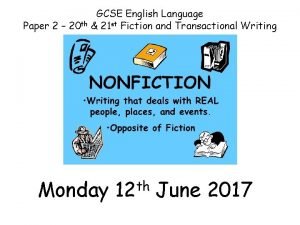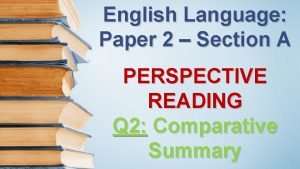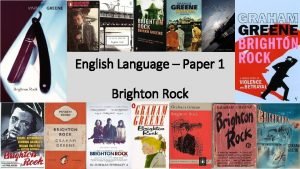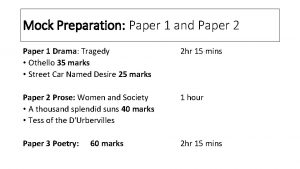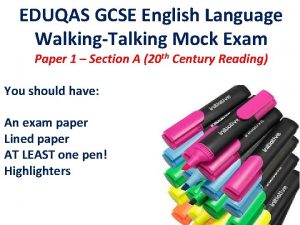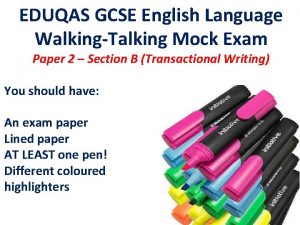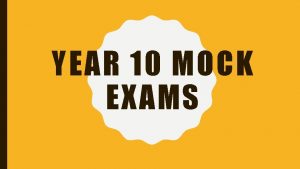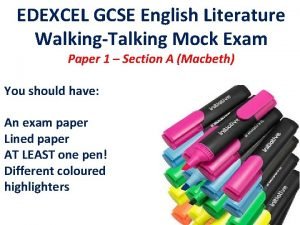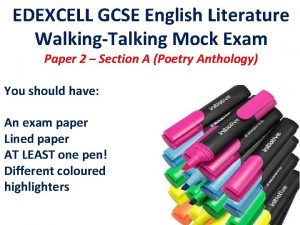English Language mock exam preparation unit Language Paper












- Slides: 12

English Language mock exam preparation unit Language Paper 1 mock - 26 th June 1 hour 45 mins Worth 50% of GCSE Literature mock – 28 th June 2 hours 15 mins Worth 50% of GCSE These are formal end of year examinations and will be marked by your teachers. You will receive your results in an envelope when you return to school in September. You will receive an overall 9 -1 grade as if this were your real GCSE. This may determine set changes and how much intervention you will be required to attend throughout Year 11.

English Language specification at a glance 2 of x Copyright © AQA and its licensors. All rights reserved.

LESSON 1 English Language Paper 1: Explorations in creative reading and writing SECTION A: Reading skills WALT: • Know the format of the exam paper; • Understand apply the correct strategies for Question 1 and Question 2.

15 mins Reading and planning time Section A: Reading You will be asked to read answer four questions based on one fiction text. Q 1: Information retrieval (4 marks) Q 2: Analysis of language (8 marks) Q 3: Analysis of structure (8 marks) Q 4: Making judgements on a text/defending a viewpoint (20 marks) Section B: Writing You will be asked to write to describe or narrate. (40 marks)

Source A: Jamaica Inn This extract is from a novel by Daphne Du Maurier. It was written in 1936, but it is set in the past. In this section a coach and horses, with its passengers, is making its way through Cornwall to Jamaica Inn. Let’s read the source together first. On first reading, you should aim to get a general understanding of the passage: Who are the characters? What happens? Does anything change over the course of the passage?

5 mins Question 1: list 4 things… 1. Read again the first part of the source, lines 1 to 7. List four things from this part of the text about the weather in Cornwall. Take note of these – [4 marks] you will not get marks for material taken from outside the stated lines! Step 1: Read the question and underline exactly what it is asking you to look for, i. e. weather in Cornwall. Step 2: Draw a box around the correct lines of the passage.

Your box should contain this paragraph: It was a cold grey day in late November. The weather had changed overnight, when a backing wind brought a granite sky and a mizzling rain with it, and although it was now only a little after two o’clock in the afternoon the pallor of a winter evening seemed to have closed upon the hills, cloaking them in mist. It would be dark by four. The air was clammy cold, and for all the tightly closed windows it penetrated the interior of the coach. The leather seats felt damp to the hands, and there must have been a small crack in the roof, because now and again little drips of rain fell softly through, smudging the leather and leaving a dark-blue stain like a splodge of ink. Step 3: What information does this section of the passage tell us about the weather in Cornwall? Highlight any evidence you can find. Step 4: Write up your answer as a list of four bullet points. You should use the exact wording of the evidence you’ve found in the source, not your own words.

Q 1 SELF ASSESSMENT Check your answers against the following list and decide how many points you have correctly found. Give yourself a total score out of 4. Candidates may include: • It was a cold day • The weather had changed overnight • There was a wind • There was mist on the hills • The air was clammy • The air was cold • It was raining Or any other valid responses that you are able to verify with your teacher having checked the source.

Question 2: how does the writer’s use of language… 10 mins 2. Look in detail at this extract from lines 8 to 17 of the source: The wind came in gusts, at times shaking the coach as it travelled round the bend of the road, and in the exposed places on the high ground it blew with such force that the whole body of the coach trembled and swayed, rocking between the high wheels like a drunken man. The driver, muffled in a greatcoat to his ears, bent almost double in his seat in a faint attempt to gain shelter from his own shoulders, while the dispirited horses plodded sullenly to his command, too broken by the wind and the rain to feel the whip that now and again cracked above their heads, while it swung between the numb fingers of the driver. The wheels of the coach creaked and groaned as they sank into the ruts on the road, and sometimes they flung up the soft spattered mud against the windows, where it mingled with the constant driving rain, and whatever view there might have been of the countryside was hopelessly obscured. How does the writer use language here to describe the effects of the weather? You could include the writer’s choice of: • Words and phrases • Language features and techniques • Sentence forms [8 marks] Think about how the writer uses words for effect This might include features such as repetition, figurative language and punctuation used for effect Focus on variations in sentence lengths and structures for effect.

Interesting verb choices These verbs all add together to build a sense the coach is out of control because of the fierce wind– all suggest the weather is powerful Long, complex sentence The wind came in gusts, at times shaking the coach as it travelled round the bend of the road, and in the exposed places on the high ground it blew with such force that the whole body of the coach trembled and swayed, rocking between the high wheels like a drunken man. The driver, muffled in a greatcoat to his ears, bent almost double in his seat in a faint attempt to gain shelter from his own shoulders, while the dispirited horses plodded sullenly to his command, too broken by the wind and the rain to feel the whip that now and again cracked above their heads, while it swung between the numb fingers of the driver. Whole first paragraph is one sentence, reflecting onward movement of the coach – the wind is propelling it along. Simile Reader visualises the coach lurching haphazardly Reader understands its movement is out of control, which again makes the wind seem powerful, capable of creating chaos The wheels of the coach creaked and groaned as they sank into the ruts on the road, and sometimes they flung up the soft spattered mud against the windows, where it mingled with the constant driving rain, and whatever view there might have been of the countryside was hopelessly obscured. Step 1: Highlight and label • any interesting words or phrases you can find that describe the effects of the weather. • any language devices the writer uses to describe the effects of the weather. • any short, simple sentences that describe the effects of the weather. • any longer, complex sentences that describe the effects of the weather. Step 2: Annotate the extract with notes on the effect of each feature of language you have identified. Why has the writer used this? What’s the effect – what does it make the reader think, feel, visualise, understand?

Question 2: how does the writer’s use of language… 10 mins Use your notes to write an answer to Q 2. Structuring your response: Paragraph 1: interesting words and phrases Firstly, the writer uses several examples of powerful words and phrases… Paragraph 2: language features and techniques Additionally, the writer’s use of language features adds to the overall effect… Paragraph 3: sentence forms The writer has deliberately crafted the sentences in this extract…

Q 2 self-assessment • • detailed, perceptive analysis (7 -8 marks) clear, relevant explanation (5 -6 marks) Some understanding and comment (3 -4 marks) simple, limited comment (1 -2 marks) Which band would you place you own answer in according to these descriptions? In green pen, write down the descriptor you think most closely matches the quality of your answer, and give yourself a mark. Your teacher will also mark this to verify it.
 Structure of poem
Structure of poem Ict mock exam
Ict mock exam Reading mock exam
Reading mock exam Paper 2 aice general paper
Paper 2 aice general paper Ap english language and composition exam format
Ap english language and composition exam format Ap english language and composition midterm exam
Ap english language and composition midterm exam Aqa english language paper 1
Aqa english language paper 1 Pearson gcse english language
Pearson gcse english language English paper 1 june 2021
English paper 1 june 2021 Igcse english language paper 1 tips
Igcse english language paper 1 tips English language paper 2 transactional writing
English language paper 2 transactional writing English language paper 2 rail disasters mark scheme
English language paper 2 rail disasters mark scheme Brighton rock question 2 model answer
Brighton rock question 2 model answer
